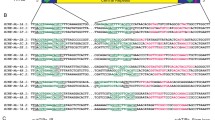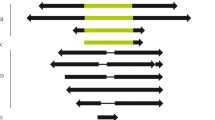Abstract
In this work the structural variations of Terminal Inverted Repeats (TIR) of Bari like transposons in Drosophila species has been studied. The aim is to try and assess the relevance of different variants in the evolutionary distribution of Bari elements. Bari is a member of the widespread Tc1 superfamily of transposable elements that has colonized most species of the Drosophila genus. We previously reported the structure of two related elements that differ in their TIR organization: Bari1 harbouring 26-bp TIR (short TIRs) and Bari2 with about 250-bp TIR (long TIR). While elements with short TIRs are complete and potentially autonomous, long ones are invariably composed of defective copies. The results show that in D. pseudobscura, D. persimilis and D. mojavensis, there is a third class of Bari elements, Bari3, that exhibit a long TIR structure and are not defective. Phylogenetic relationships among reconstructed transposases are consistent with the three subfamilies sharing a common origin. However, the final TIR organization into long or short structure is not related by descent but appears to be lineage-specific. Furthermore, we show that, independently of origin and organization, within the 250-bp terminal sequences there are three regions that are conserved in both sequence and position suggesting they are under functional constraint.





Similar content being viewed by others
References
Arcà B, Savakis C (2000) Distribution of transposable element Minos in the genus Drosophila. Genetica 108:263–267
Atschul SF, Madden TL, Scaffer AA, Zhang J, Zhang Z, Miller W, Lipman DJ (1997) Gappped BLAST and PSI-BLAST: a new generation of protein database search program. Nucleic Acids Res 25:3389–3402
Biémont C, Cizeron G (1999) Distribution of transposable elements in Drosophila species. Genetica 105:43–62
Brennecke J, Aravin AA, Stark A, Dus M, Kellis M, Sachidanandam R, Hannon GJ (2007) Discrete Small RNA-Generating Loci as Master Regulators of Transposon Activity in Drosophila. Cell 128:1–15
Brillet B, Bigot Y, Augé-Gouillou C (2007) Assembly of the Tc1 and mariner transposition initiation complexes depends on the origin of their transposase DNA binding domains. Genetica 130:105–120
Caizzi R, Caggese C, Pimpinelli S (1993) Bari-1, a new transposon like family in Drosophila melanogaster with a unique heterochromatic organization. Genetics 133:335–345
Cui Z, Geurts AM, Liu G, Kaufman CD, Hackett PB (2002) Stucture-Function analysis of the inverted terminal repeats of the sleeping beauty transposon. J Mol Biol 318:1221–1235
Finnegan DJ (1992) Transposable elements. Curr Opin Genet Dev 2:861–867
Fisher SE, van Luenen HGAM, Plasterk RHA (1999) Cis requirements for transposition of Tc1-like transposons in C. elegans. Mol Gen Genet 262:268–274
Franz G, Savakis C (1991) Minos, a new transposable element from Drosophila hydei, is a member of the Tc1 family of transposons. Nucleic Acids Res 19:6646
Gunawardane LS, Saito K, Nishida KM, Miyoshi K, Kawamura Y, Nagami T, Siomi H, Siomi MC (2007) A Slicer-Mediated Mechanism for Repeat-Associated siRNA 5´ End Formation in Drosophila. Science 315:1587–1590
Ivics Z, Hackett PB, Plasterk RH, Izsvák Z (1997) Molecular reconstruction of Sleeping Beauty, a Tc1-like transposon from fish, and its transposition in human cells. Cell 91:501–510
Izsvák Z, Ivics Z, Hackett PB (1995) Characterization of a Tc1-like transposable element in zebrafish (Danio rerio). Mol Gen Genet 247:312–322
Izsvák Z, Ivics Z, Plasterk RH (2000) Sleeping Beauty, a wide host-range transposon vector for genetic transformation in vertebrates. J Mol Biol 302:93–102
Izsvák Z, Khare D, Behlke J, Heinemann U, Plasterk RH, Ivics Z (2002) Involvement of a bifunctional, paired-like DNA-binding domain and a transpositional enhancer in Sleeping Beauty transposition. J Biol Chem 277:34581–34588
Junakovic N, Di Franco C, Terrinoni A (1997) Evidence for a host role in regulating the activity of transposable elements in Drosophila melanogaster: the case of the persistent instability of Bari 1 elements in Charolles stock. Genetica 100:149–154
Kaminker JS, Bergman CM, Kronmiller B, Carlson J, Svirskas R, Patel S, Frise E, Wheeler DA, Lewis SE, Rubin GM, Ashburner M, Celniker SE (2002) The transposable elements of the Drosophila melanogaster euchromatin: a genomics perspective. Genome Biol 3:research0084.1–0084.20
Ke Z, Grossman GL, Cornel AJ, Collins FH (1996) Quetzal: A transposon of the Tc1 family in the mosquito Anopheles almimanus. Genetica 98:141–147
Kidwell MG, Lisch D (2001) Perspective: transposable elements, parasitic DNA, and genome evolution. Evolution 55:1–24
Kipling D, Warburton PE (1997) Centromeres, CENP-B and Tigger too. Trends Genet 13:141–145
Krasnov A, Koskinen H, Afanasyev S, Molsa H (2005) Transcribed Tc1-like transposon in salmonid fish. BMC Genomics 6: article n.107
Lam WL, Seo P, Robison K, Virk S, Gilbert W (1996) Discovery of amphibian Tc1-like transposon family. J Mol Biol 257:359–366
Lampe DJ, Churchill MEA, Robertson HM (1996) Purified mariner transposase is sufficient to mediate transposition in vitro. EMBO J 15:5470–5479
Lemeunier F, David JR, Tsacas L, Ashburner M (1986) The melanogaster species group. In: Ashburner M, Carson HL, Thompson JN (eds) The genetics and biology of drosophila. New York Academic Press, New York, pp 147–256
Lerat E, Rizzon C, Biémont C (2003) Sequence divergence within transposable element families in the Drosophila melanogaster genome. Genome Res 13:1889–1896
Le Rouzic A, Capy P (2006) Population genetics models of competition between transposable element subfamilies. Genetics 174:785–793
Li YJ, Satta Y, Takahata N (1999) Paleo-demography of the Drosophila melanogaster subgroup: Application of the maximum likelihood method. Genes Genet Syst 74:117–127
Lohe AR, Hartl DL (1996) Autoregulation of mariner transposase activity by overproduction and dominant-negative complementation. Mol Biol Evol 13:549–555
Lohe AR, Morijyama EN, Lidholm DA, Hartl DL (1995) Horizontal transmission, Vertical inactivation, and Stochastic loss of mariner-like transposable elements. Mol Biol Evol 12:62–72
Merriman PJ, Grimes CD, Ambroziak J, Hackett DA, Skinner P, Simmons MJ (1995) S elements: a family of Tc1-like transposons in the genome of Drosophila melanogaster. Genetics 141:1425–1438
Moschetti R, Caggese C, Barsanti P, Caizzi R (1998) Intra- and interspecies variation among Bari-1 elements of the melanogaster species group. Genetics 150:239–250
Petrov DA, Schutzman JL, Hartl DL, Lozovskaya ER (1995) Diverse transposable elements are mobilized in hybrid dysgenesis in Drosophila virilis. Proc Natl Acad Sci USA 92:8050–8054
Plasterk RHA, Izsvak Z, Ivics Z (1999) Resident aliens: the Tc1/mariner superfamily of transposable elements. Trends Genet 15:326–332
Radice AD, Bugaj B, Fitch DH, Emmons SW (1994) Widespread occurrence of the Tc1 transposon family: Tc1-like transposons from teleost fish. Mol Gen Genet 244:606–612
Russo CAM, Takezaki N, Nei M (1995) Molecular phylogeny and divergence times of drosophilid species. Mol Biol Evol 12:391–404
Saitou N, Nei M (1987 The neighbor-joining method: a new method for reconstructing phylogenetic trees. Mol Biol Evol 4:406–425
Sijen T, Plasterk RHA (2003) Transposon silencing in the Caenorhabtisis elegans germ line by natural RNAi. Nature 426:310–314
Thompson JD, Higgins DG, Gibson TJ (1994) CLUSTAL W: improving the sensitivity of progressive multiple sequence alignment through sequence weighting, position-specific gap penalties and weight matrix choice. Nucleic Acids Res 22:4673–4680
Vos JC, De Baere I, Plasterk RHA (1996) Transposase is the only nematode protein required for in vitro transposition of Tc1. Genes Dev 10:755–761
Wang R, Hey J (1996) The Speciation history of Drosophila pseudoobscura and Close Relatives: Inferences from DNA Sequence Variation at the Period Locus. Genetics 144:1113–1126
Zayed H, Izsvak Z, Khare D, Heinemann U, Ivics Z (2003) The DNA-binding protein HMGB1 is a cellular cofactor of Sleeping Beauty transposition. Nucleic Acids Res 31:2313–2322
Acknowledgments
We thank C. Caggese for discussion and S. Marconi, F. Manodoro for technical support. P. D’Addabbo helped execute the figures. This investigation received financial support from the University of Bari (Progetti di Ateneo) and from Ministero dell’Istruzione, Università e Ricerca, Italy (PRIN).
Author information
Authors and Affiliations
Corresponding author
Additional information
Communicated by S. Hohmann.
Nucleotide sequence data from this article have been deposited in the EMBL/GenBank databases with the accession numbers: AM493769, AM493770, AM493771, AM493772.
Rights and permissions
About this article
Cite this article
Moschetti, R., Chlamydas, S., Massimiliano Marsano, R. et al. Conserved motifs and dynamic aspects of the terminal inverted repeat organization within Bari-like transposons. Mol Genet Genomics 279, 451–461 (2008). https://doi.org/10.1007/s00438-008-0324-7
Received:
Accepted:
Published:
Issue Date:
DOI: https://doi.org/10.1007/s00438-008-0324-7




